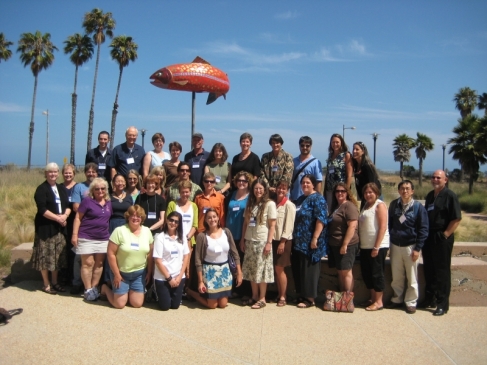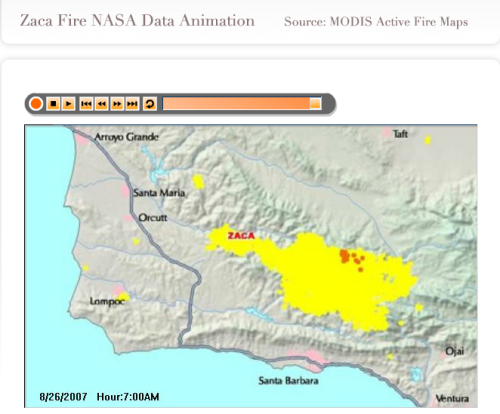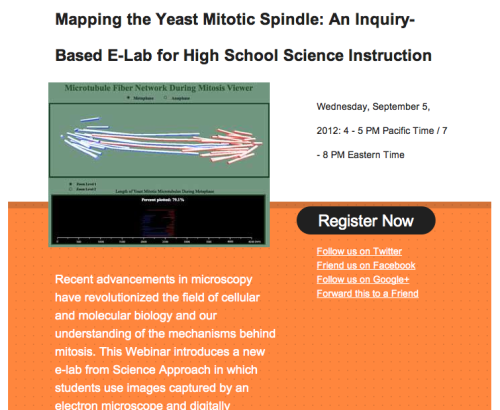Join the discussion about building science tools and communication on Drupal!
Category Archives: Projects
Science on Drupal at BadCamp
Comments Off on Science on Drupal at BadCamp
October 16, 2012 · 9:25 pmNMRI interactive brain data viewer demo
One the the outcomes from the Vision Project was an interactive brain data viewer, programmed by Marty Landsfeld at the NMRI.
Funded by the NIH, with project partner Science Approach, this tool has been integrated into a curriculum on:
Introducing Alcohol and the Hippocampus: An Inquiry-Based E-Lab for High School Science Instruction
Comments Off on NMRI interactive brain data viewer demo
Filed under Projects
World Ocean Atlas Viewer
NOTE: this was completed in 2008, but it still (for now) works.
The WOA viewer brings the entire NOAA World Ocean Atlas 2005 ocean chemistry climatologies into one easy to use viewer.
This downloadable application for the MAC or PC is free to use for educational purposes.
DOWNLOAD: World Ocean Atlas Viewer NOTE: 500 MB download.
For more information on the dataset, visit the NODC website FAQ page .
More WOA information at Wikipedia: World Ocean Atlas.
Comments Off on World Ocean Atlas Viewer
Filed under Projects
NMRI Technologies
The Institute has staff and partners who are expert in a wide range of media and information technologies, as well as earth science, geography, sociology, and marine science.
The New Media Research Institute has wide-ranging interests in the theories and applications of information technology in education. We are particularly interested in the promise of geographic information systems (GIS) and in the future role of digital libraries. Below is a partial list of our current interests.
- Drupal development
- Data access software applications for education
- Data visualization theories and application development
- Data metadata and server-side and middleware issues
- Multicasting in education
- Digital library organization
- Smart clients for digital library users
- Personal digital collections
- Sharable personal digital libraries
- 3- and 4D displays of information
- Data fusion between raster and vector data sources
- Distributed delivery systems
- Open access publishing informatics and sociology
- Social organization of digital communities
Comments Off on NMRI Technologies
Filed under Projects
NASA ACCESS DIAL Project Technology Real-Time ZACA Fire Animation 2007
Started July 4, 2007, the Zaca fire burned for nearly two months before it was contained on September 2, 2007. Nearby Santa Barbara City residents watched and waited while this, the largest fire in the history of the county (240,207 acres total), moved ever closer to the inhabited front country. As firefighters battled, NASA’s MODIS Active Fire Mapping Program captured the active burn area several times a day. At the end of August, with towering heat clouds in the sky and ash covering the ground in Santa Barbara City, ACCESS DIAL project technical lead, Marty Landsfeld, noticed satellite data images in the local papers and determined that an animation of the progression of the fire would help inform the population. In one afternoon, using the DIAL technology, he was able to assemble an animation of 104 MODIS data images, including their date and time information. On August 28, the Zaca Fire NASA Data Animation was hosted on the web at NASA Zaca fire data animation.
The URL was seeded to local media outlets. Within 48 hours more than 1000 information-hungry users viewed this resource. The DIAL technology leverages ITTVis’s IDL software for data access and analysis with Adobe Director’s user interface authoring tools.
Comments Off on NASA ACCESS DIAL Project Technology Real-Time ZACA Fire Animation 2007
Filed under Projects
A New VISION for the Research Institute!
In August, 2009, The Instititute received word that the Phase II STTR project, Volumetric Imaging for Science Instruction of an Open Nature, has been funded by the Eunice Kennedy Shriver National Institute of Child Health & Human Development.
The goal of this Phase II Small Business Technology Transfer (STTR) project is to adapt an advanced technology employed in biomedical research and practice—volumetric image processing and analysis (VIPA)—for science and mathematics education in formal secondary school settings. VIPA is used in biomedicine to display, model, and analyze volumetric data—typically imaging data that has been created by making two-dimensional digital “slices” of an object of interest—such as in magnetic resonance imaging (MRI), functional MRI (fMRI), computed tomography (CT), and single photon emission computed tomography (SPECT). VIPA is also employed in non-biomedical disciplines where volumetric analyses are of interest, for instance, Earth science, engineering, hydrology, oceanography, and oil and gas exploration.
This project will create five e-Learning modules designed to supplement high school biology, Advanced Placement (AP) anatomy and physiology, and AP Biology instruction. The modules will be developed in an inquiry learning (IL) format in which students play the role of imaging scientists. Students will explore fascinating 3-D images; expand spatial thinking abilities by navigating 3-D data visualizations and changing the way the data is represented; master new quantification and technology skills by selecting and measuring features in microscopic and macroscopic specimens; enhance science process skills by working through all stages of a virtual research project; and learn standards-based science content.
The materials will be developed by the New Media Research Institute, in collaboration with Science Approach, LLC, the Biomedical Imaging Resource at the Mayo Clinic, ten experienced teachers, five researchers, a commercialization advisor from the Carolina Biological Supply Company, and the West Texas Office of Evaluation and Research. The VISION modules will be released as a online Moodle courses available for a nominal cost by subscription.
Comments Off on A New VISION for the Research Institute!
Filed under Projects
Skolr: the Digital Science Poster Service and Repository
Each year, US researchers spend 4000 person years creating and exhibiting posters at meetings (globally it could well be 10 times this number). Science (and engineering) posters are a window into the state of knowledge and research at hundreds of universities and research laboratories. These posters are designed to highlight the latest achievements… years before these are published. Often displayed for a few hours to several individuals, the posters are generally tossed away (as is their ephemeral fate). The equivalent of centuries of work dumped into landfills without a trace each year. In January 2011, the Federation had a better idea; In the hallway of the Winter 2011 ESIP Federation Meeting, a conversation was started on the value of a digital poster service for the ESIP meetings: the initial added value was access—access across the whole Federation, and access across time. The notion of an ESIP Digital Poster Service was born. Within a month, this conversation was expanded to include the Alfred P. Sloan Foundation. Within 3 months the pilot effort was funded to be tested at the 2011 Summer ESIP meeting. Beyond the scope of the Federation, the idea of an academy-wide digital poster commons captures the real value that science/engineering posters bring to the research endeavor. When combined with semantic and geographic services, posters become postcards that science teams send out to the entire academy… seeking for new ideas and potential new collaborations.
TOP 10 Potential Benefits of Skolr
1. Improve the ROI for hundreds of thousands of science posters each year
2. Improve the experience at thousands of science meetings each year
3. Accelerate the pace of science communication
4. Accelerate the rate of science innovation
5. Build a global real-time commons for research in-progress
6. Connect hundreds of third-world scientists to their first-world peers
7. Help thousands of graduate students find research collaborators
8. Build discoverable links between research, data, and null-results
9. Create active links between science domains
10. Build a researchable archive for millions of science posters for decades to come
Here are some next steps:
- Review the pilot test and record lessons learned for the next phase.
- Develop partnerships with other Earth Science meeting organizers (and then, other disciplines) to add more meetings.
- Acquire support for a more robust digital meeting poster service that can accommodate a wide range of meeting requirements.
- Build the poster commons metadata requirements and APIs to the open-source poster service.
- Enlist experts and stakeholders in the conversation about the merits, opportunities, and complexities of this service.
The Skolr project is grateful to the following Funders:
Comments Off on Skolr: the Digital Science Poster Service and Repository
Filed under Projects
NMRI a partner in MacArthur Foundation funded “Sampling the Sea”
Posted April 24th, 2009  (Santa Barbara, Calif.) –– The John D. and Catherine T. MacArthur Foundation today announced that the Carsey-Wolf Center for Film, Television, and New Media at UC Santa Barbara is one of 14 institutions throughout the world to be awarded a prestigious Digital Media and Learning Innovation grant.
(Santa Barbara, Calif.) –– The John D. and Catherine T. MacArthur Foundation today announced that the Carsey-Wolf Center for Film, Television, and New Media at UC Santa Barbara is one of 14 institutions throughout the world to be awarded a prestigious Digital Media and Learning Innovation grant.
Selected from among more than 700 proposals, the winning projects from universities, individuals, and organizations are expected to make pioneering contributions to the emerging field of digital media education. The MacArthur Foundation distributed a total of $2 million to develop novel learning environments using a broad range of digital media tools.
The Digital Media and Learning Competition is part of the foundation’s $50 million initiative designed to help determine how digital technologies are changing the way young people learn, play, socialize, and participate in civic life.
MacArthur president Jonathan Fanton described the winners as “true exemplars of how digital media are transforming the way we think and learn.”
UCSB’s Carsey-Wolf Center received $211,000 to support a multidisciplinary entrepreneurial ocean science education and social networking initiative. Titled “DigitalOcean: Sampling the Sea,” the pilot project will focus on ocean sustainability and engage 200 middle and high school classrooms around the globe in a dynamic online international learning community. Participants will collect and share data, images, and stories about seafood choices in their communities and learn how these choices affect the health of the world’s oceans.
“Sampling the Sea uses multidisciplinary teams of students, scientists, and new media experts, partnering with Google Ocean, NASA GLOBE, and ePals, to engage the next generation of consumers in a global dialogue on the interrelationships among local human customs, regulatory laws, fishing practices, wildlife management, and the future of the sea,” said Constance Penley, project leader and co-director of the Carsey-Wolf Center.
The UCSB initiative is important because it uses innovative participatory learning techniques such as online social networking, photo sharing, “mashing-up,” and gaming to bring ocean literacy to classrooms where today it is almost entirely missing.
“With the majority of the world’s fisheries projected to collapse by the middle of the 21st Century, and nearly a third of major fish species already seriously depleted, it is vital that young people collaborate on understanding the implications of how we harvest and consume seafood if we are to create a cultural consensus to address this problem before it is too late,” noted Penley, who is also a professor of film and media studies. “We want to create a fan base for the ocean.”
Additional UCSB researchers participating in the project are Steven Gaines, director of the Marine Science Institute and professor of ecology, evolution, and marine biology; John Melack, acting dean of the Donald Bren School of Environmental Science and Management and professor of ecology, evolution, and marine biology; Ronald E. Rice, co-director of the Carsey-Wolf Center and Arthur N. Rupe professor of communication; Cathy Boggs, associate director of the Carsey-Wolf Center; and Bruce Caron, project manager and executive director of the New Media Research Institute in Santa Barbara.
At the Carsey-Wolf Center for Film, Television, and New Media, scholars from UCSB’s nationally renowned departments of film and media studies and communication collaborate with researchers drawn from all of the university’s schools and divisions to study everything from silent films to the latest in digital media and satellite communications. It is one of the first centers at a major university where faculty from the arts, humanities, and sciences collaborate to teach and study mass media from a variety of social, cultural, historical, and scientific perspectives.
The Carsey-Wolf Center’s Environmental Media Initiative brings media and communication scholars together with environmental scientists to engage in teaching and research. “Sampling the Sea” is a pilot project of the Environmental Media Initiative’s “DigitalOcean,” an ocean science education and social networking infrastructure project to create international, multigenerational communities working for ocean conservation. Support for the initial development of DigitalOcean was provided by the Paul G. Allen Family Foundation.
The Digital Media and Learning Competition is funded by a MacArthur Foundation grant to UC Irvine and Duke University. It is administered by the Humanities, Arts, Science and Technology Advanced Collaboratory, a virtual network of learning institutions committed to new forms of collaboration across communities and disciplines fostered by the creative use of technology.
The John D. and Catherine T. MacArthur Foundation is a private, independent grant-making institution helping to build a more just and sustainable world. Through the support it provides, the foundation fosters the development of knowledge, nurtures individual creativity, strengthens institutions, helps improve public policy and provides information to the public, primarily through support for public interest media. With assets of more than $6.4 billion, the foundation makes approximately $225 million in grants annually and works in 60 countries.
Comments Off on NMRI a partner in MacArthur Foundation funded “Sampling the Sea”
Filed under Projects
NASA picks New Media Research Institute to help coordinate its earth science internet technology effort
 NASA Science on Drupal Central Project, a collaboration between the New Media Research Institute in Santa Barbara and a team at the University of Alabama, Huntsville, has received two years of funding from the NASA Science Mission Directorate Research Opportunities in Space and Earth Sciences Advancing Collaborative Connections for Earth System Science (NNH11ZDA001N-ACCESS).
NASA Science on Drupal Central Project, a collaboration between the New Media Research Institute in Santa Barbara and a team at the University of Alabama, Huntsville, has received two years of funding from the NASA Science Mission Directorate Research Opportunities in Space and Earth Sciences Advancing Collaborative Connections for Earth System Science (NNH11ZDA001N-ACCESS).
Bruce Caron, Executive Director of the New Media Studio, and principal investigator for the Project notes, “Drupal hosting, administration, user interface work, and service and tool integration on Drupal sites are already widespread activities within NASA earth science. Many NASA Centers, funded projects, and other partners are in the process of, or have completed the migration of, their content onto Drupal.”
The NASA Science on Drupal Central (NSODC) project will offer key support and a centralized knowledge base focused on the use of Drupal with existing and emerging NASA earth data collections and services. NSODC will deliver a Drupal site where NASA scientists and technicians can share their Drupal lessons learned, register their code contributions to the Drupal code collection, discuss issues of NASA-specific common interest, and search, find, and reuse NASA-funded Drupal code.
NSODC will also provide a home for more general, Drupal-wide knowledge sharing aimed to support Drupal site administrators across NASA Earth Science; however, its main focus will be on science and data tools on Drupal. NSODC will host Drupal Camps at summer ESIP Federation meetings, and coordinate Drupal discussions and activities at NASA workshops. The project will coordinate with the growing Drupal development community (drupal.org) to add new open-source code resources.
NSODC will also build and share some tool frameworks on existing Drupal modules. These can be reused and customized by others to accelerate NASA data tool development on Drupal. Tools and code are one half of the effort. The other half is community-building support. NASA Science on Drupal will engage NASA Drupal code developers and site administrators as a community of purpose and provide avenues of communication, collaboration, and resource sharing.
“Through active knowledge sharing and the resulting collective intelligence, NASA will save time and money and deliver more earth data and information using Drupal-based websites.” said Caron.
Abstracts for all funded projects are available here.
http://nspires.nasaprs.com/external/viewrepositorydocument/cmdocumentid=…
The New Media Research Institute is the research wing of the New Media Studio, Inc. a non-profit corporation based in Santa Barbara, California.









You must be logged in to post a comment.